FLAGS FLAG OF ENGLAND England’s flag


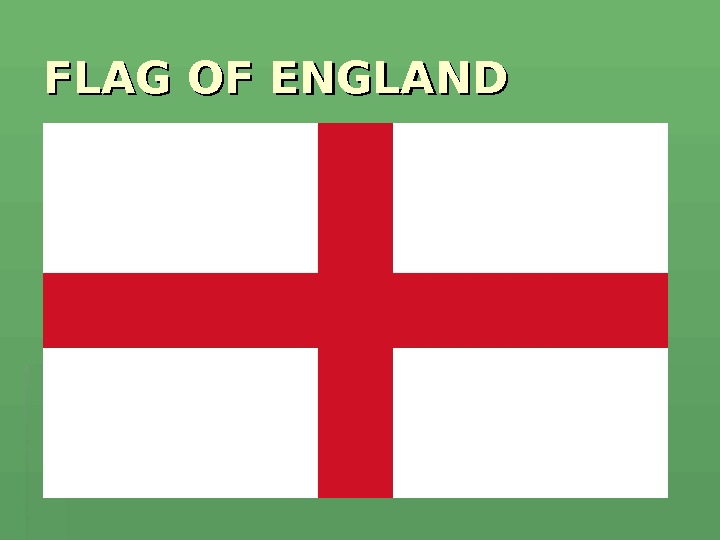
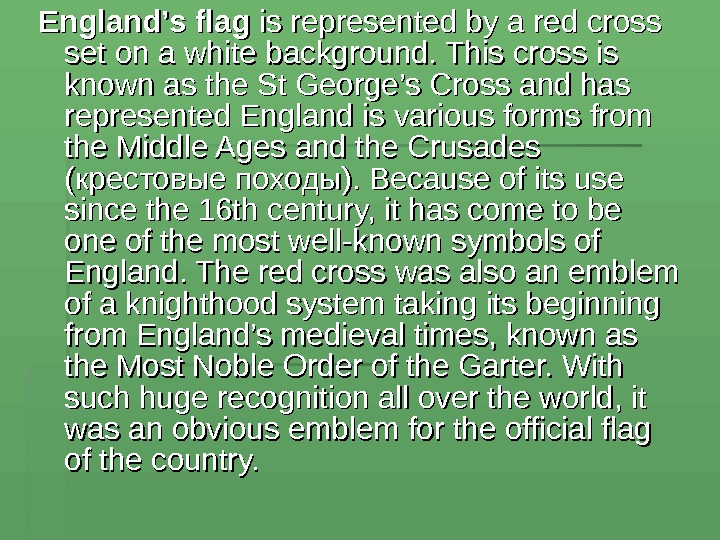
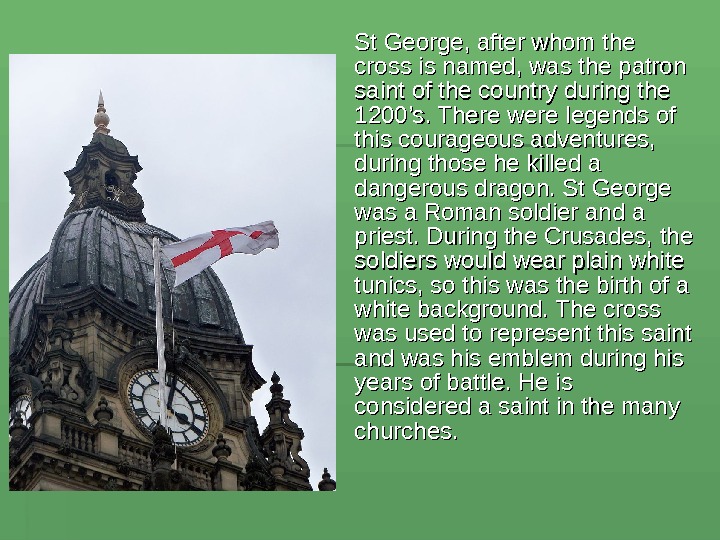

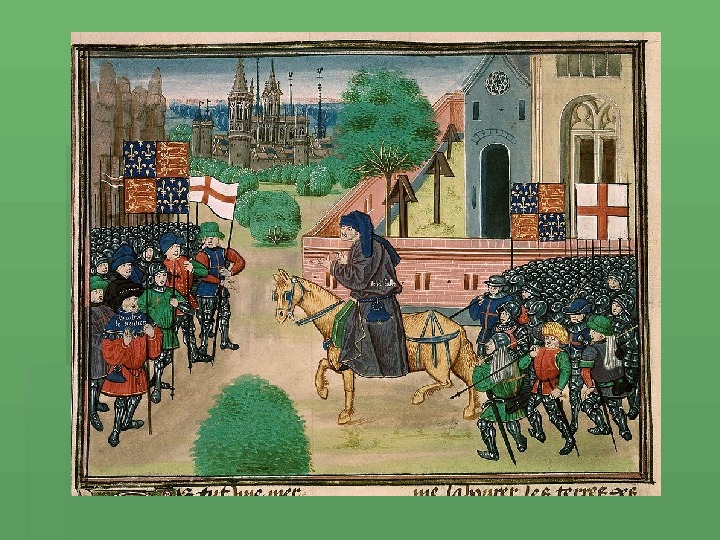
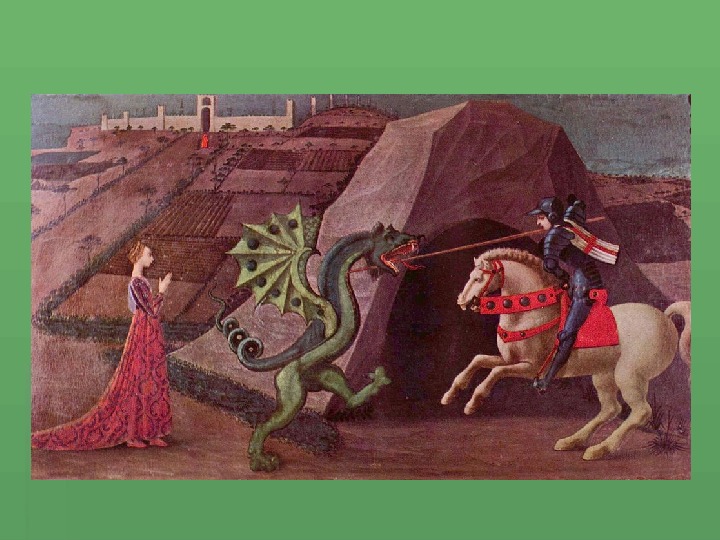
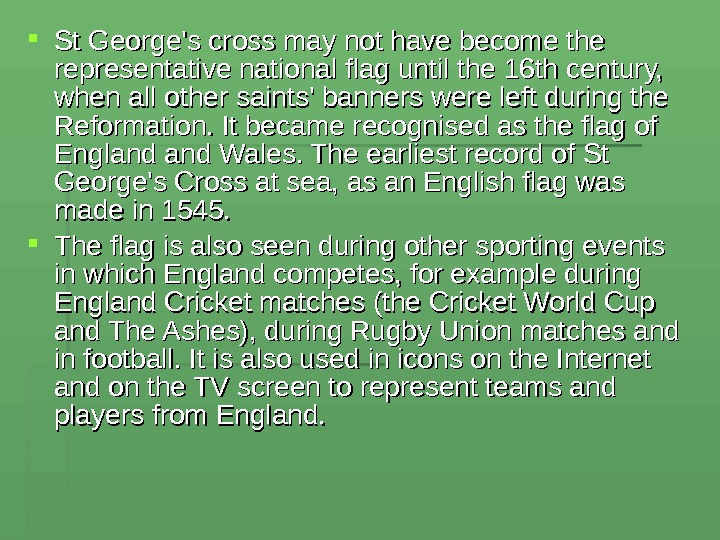

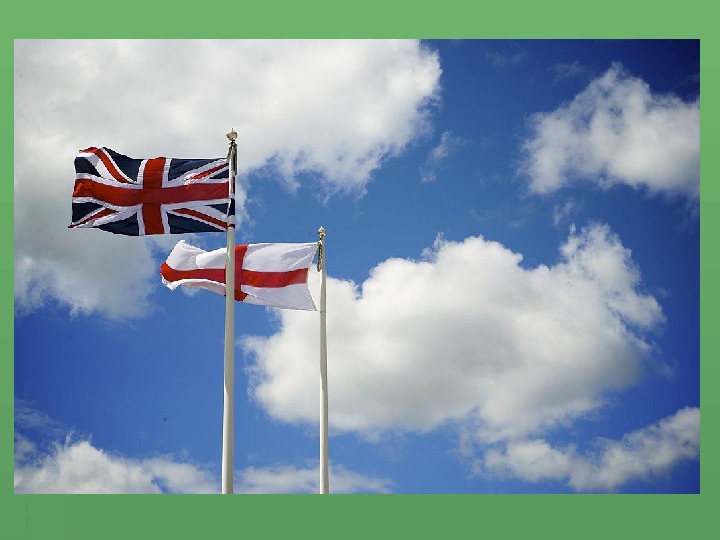
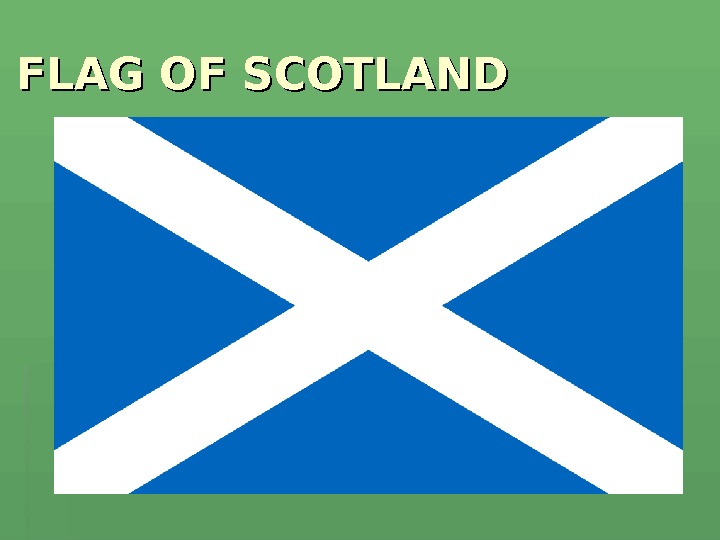
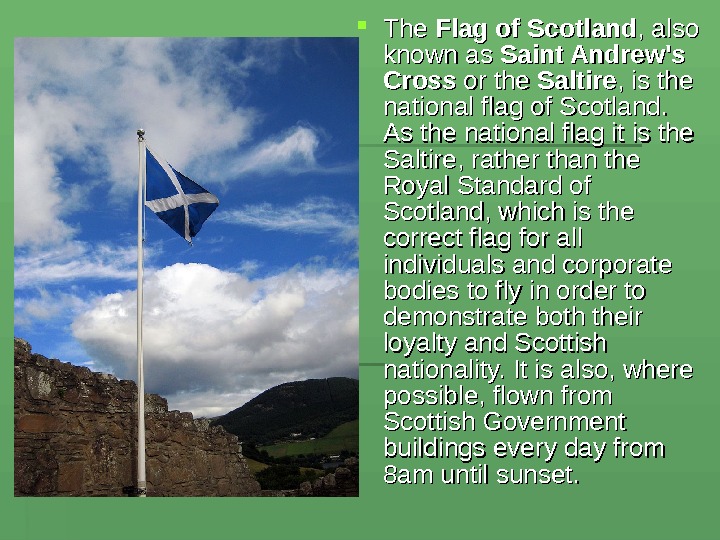
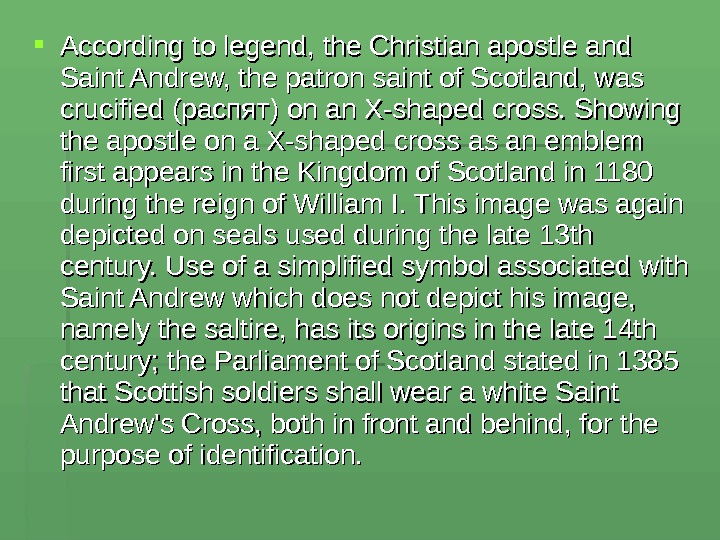
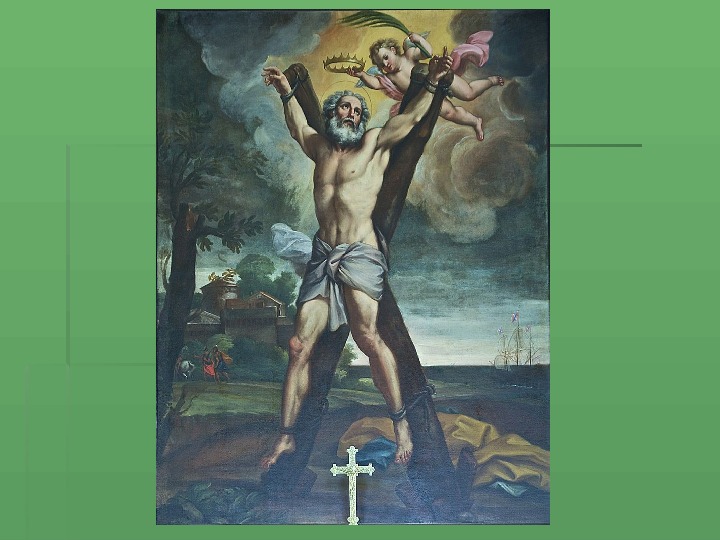




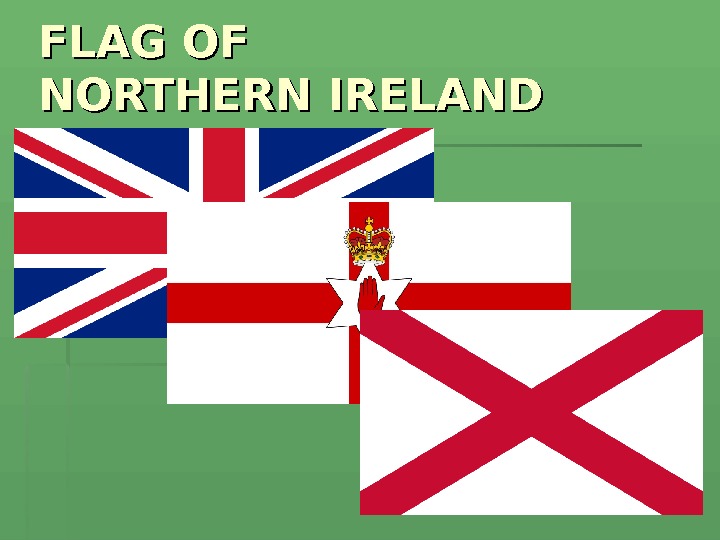

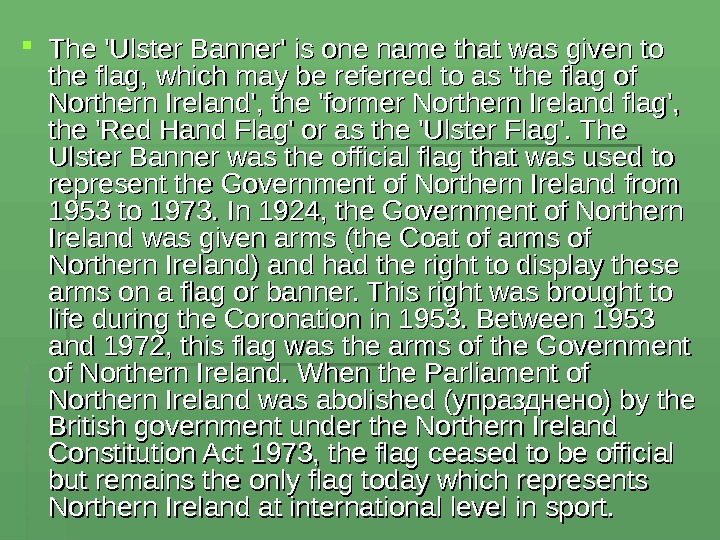
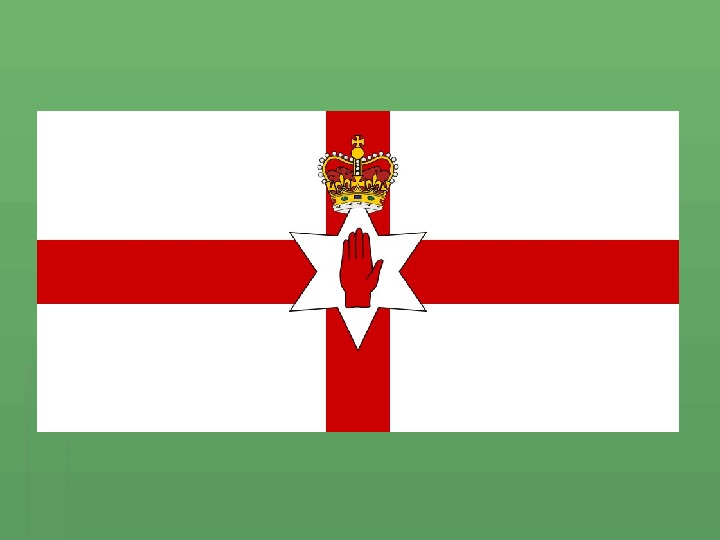
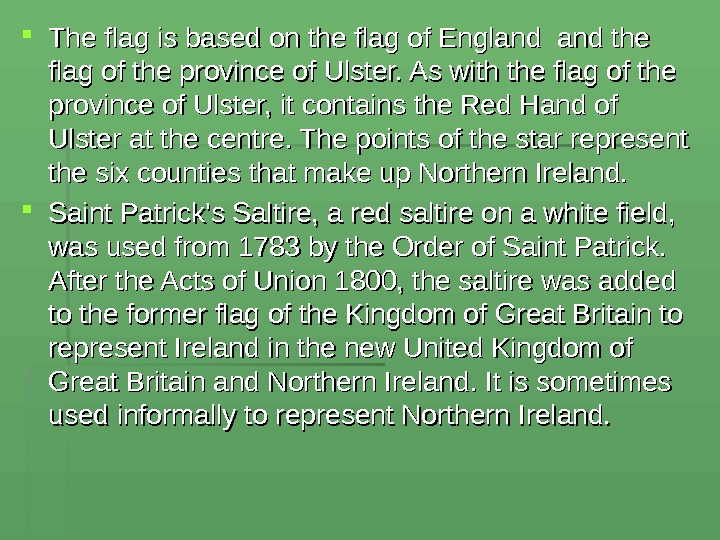
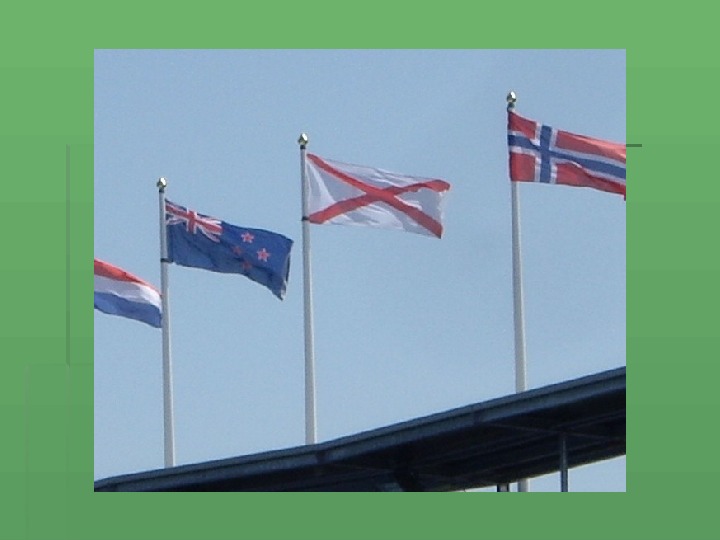
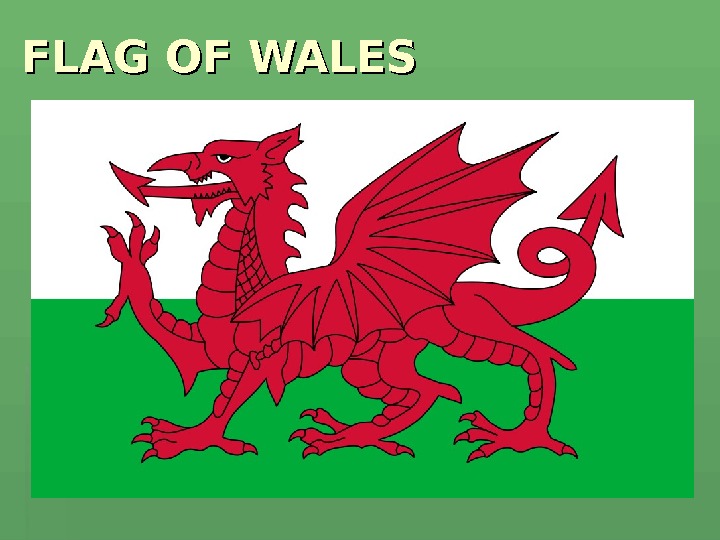


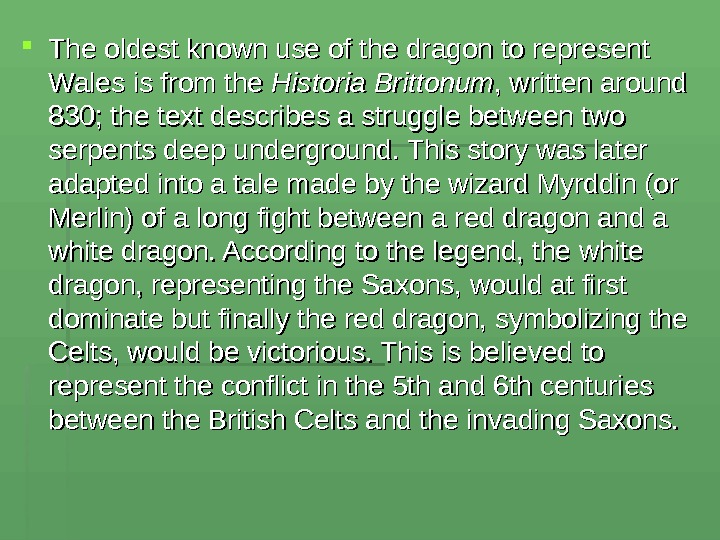

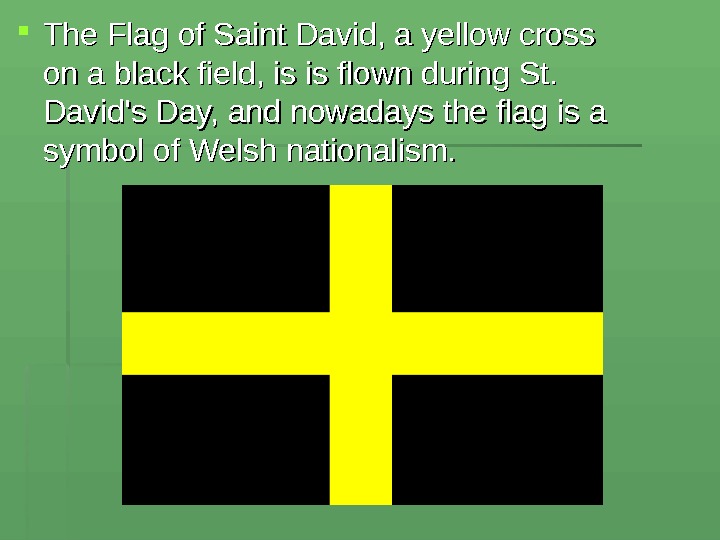
- Размер: 1.6 Mегабайта
- Количество слайдов: 30
Описание презентации FLAGS FLAG OF ENGLAND England’s flag по слайдам
 FLAGS
FLAGS
 FLAG OF ENGLAN
FLAG OF ENGLAN
 England’s flag is represented by a red cross set on a white background. This cross is known as the St George’s Cross and has represented England is various forms from the Middle Ages and the Crusades (крестов ыы е походы). Because of its use since the 16 th century, it has come to be one of the most well-known symbols of England. The red cross was also an emblem of a knighthood system taking its beginning from England’s medieval times, known as the Most Noble Order of the Garter. With such huge recognition all over the world, it was an obvious emblem for the official flag of the country.
England’s flag is represented by a red cross set on a white background. This cross is known as the St George’s Cross and has represented England is various forms from the Middle Ages and the Crusades (крестов ыы е походы). Because of its use since the 16 th century, it has come to be one of the most well-known symbols of England. The red cross was also an emblem of a knighthood system taking its beginning from England’s medieval times, known as the Most Noble Order of the Garter. With such huge recognition all over the world, it was an obvious emblem for the official flag of the country.
 St George, after whom the cross is named, was the patron saint of the country during the 1200’s. There were legends of this courageous adventures, during those he killed a dangerous dragon. St George was a Roman soldier and a priest. During the Crusades, the soldiers would wear plain white tunics, so this was the birth of a white background. The cross was used to represent this saint and was his emblem during his years of battle. He is considered a saint in the many churches.
St George, after whom the cross is named, was the patron saint of the country during the 1200’s. There were legends of this courageous adventures, during those he killed a dangerous dragon. St George was a Roman soldier and a priest. During the Crusades, the soldiers would wear plain white tunics, so this was the birth of a white background. The cross was used to represent this saint and was his emblem during his years of battle. He is considered a saint in the many churches.
 The Pope had decided that all English Crusaders should wear red tunics with white crosses, while the French chose red on white. The English then wanted to have their emblem of a red cross on a white tunic back and, in 1188, the kings of each country decided to exchange their flags. However, some of the French soldiers continued to wear their old tunics, resembling the English. For this reason, the red cross on the white background eventually became the symbol for the Crusaders, no matter what nationality soldiers had. Even Georgia (a country in Russia) used this iconic emblem of St George in the Middle Ages as he also is a patron saint of this country.
The Pope had decided that all English Crusaders should wear red tunics with white crosses, while the French chose red on white. The English then wanted to have their emblem of a red cross on a white tunic back and, in 1188, the kings of each country decided to exchange their flags. However, some of the French soldiers continued to wear their old tunics, resembling the English. For this reason, the red cross on the white background eventually became the symbol for the Crusaders, no matter what nationality soldiers had. Even Georgia (a country in Russia) used this iconic emblem of St George in the Middle Ages as he also is a patron saint of this country.


 St George’s cross may not have become the representative national flag until the 16 th century, when all other saints’ banners were left during the Reformation. It became recognised as the flag of England and Wales. The earliest record of St George’s Cross at sea, as an English flag was made in 1545. The flag is also seen during other sporting events in which England competes, for example during England Cricket matches (the Cricket World Cup and The Ashes), during Rugby Union matches and in football. It is also used in icons on the Internet and on the TV screen to represent teams and players from England.
St George’s cross may not have become the representative national flag until the 16 th century, when all other saints’ banners were left during the Reformation. It became recognised as the flag of England and Wales. The earliest record of St George’s Cross at sea, as an English flag was made in 1545. The flag is also seen during other sporting events in which England competes, for example during England Cricket matches (the Cricket World Cup and The Ashes), during Rugby Union matches and in football. It is also used in icons on the Internet and on the TV screen to represent teams and players from England.


 FLAG OF SCOTLAN
FLAG OF SCOTLAN
 The Flag of Scotland , also known as Saint Andrew’s Cross or the Saltire , is the national flag of Scotland. As the national flag it is the Saltire, rather than the Royal Standard of Scotland, which is the correct flag for all individuals and corporate bodies to fly in order to demonstrate both their loyalty and Scottish nationality. It is also, where possible, flown from Scottish Government buildings every day from 8 am until sunset.
The Flag of Scotland , also known as Saint Andrew’s Cross or the Saltire , is the national flag of Scotland. As the national flag it is the Saltire, rather than the Royal Standard of Scotland, which is the correct flag for all individuals and corporate bodies to fly in order to demonstrate both their loyalty and Scottish nationality. It is also, where possible, flown from Scottish Government buildings every day from 8 am until sunset.
 According to legend, the Christian apostle and Saint Andrew, the patron saint of Scotland, was crucified ( распят ) on an X-shaped cross. Showing the apostle on a X-shaped cross as an emblem first appears in the Kingdom of Scotland in 1180 during the reign of William I. This image was again depicted on seals used during the late 13 th century. Use of a simplified symbol associated with Saint Andrew which does not depict his image, namely the saltire, has its origins in the late 14 th century; the Parliament of Scotland stated in 1385 that Scottish soldiers shall wear a white Saint Andrew’s Cross, both in front and behind, for the purpose of identification.
According to legend, the Christian apostle and Saint Andrew, the patron saint of Scotland, was crucified ( распят ) on an X-shaped cross. Showing the apostle on a X-shaped cross as an emblem first appears in the Kingdom of Scotland in 1180 during the reign of William I. This image was again depicted on seals used during the late 13 th century. Use of a simplified symbol associated with Saint Andrew which does not depict his image, namely the saltire, has its origins in the late 14 th century; the Parliament of Scotland stated in 1385 that Scottish soldiers shall wear a white Saint Andrew’s Cross, both in front and behind, for the purpose of identification.

 The earliest reference to the Saint Andrew’s Cross as a flag is to be found in the Vienna Book of Hours , 1503, where a white saltire is depicted with a red background. In the case of Scotland, use of a blue background for the Saint Andrew’s Cross is said to date from at least the 15 th century, with the first certain illustration of a flag depicting such appearing in Sir David Lyndsay’s Register of Scottish Arms, 1542.
The earliest reference to the Saint Andrew’s Cross as a flag is to be found in the Vienna Book of Hours , 1503, where a white saltire is depicted with a red background. In the case of Scotland, use of a blue background for the Saint Andrew’s Cross is said to date from at least the 15 th century, with the first certain illustration of a flag depicting such appearing in Sir David Lyndsay’s Register of Scottish Arms, 1542.

 The legend surrounding Scotland’s association with the Saint Andrew’s Cross was related by Walter Bower who said that the flag originated in a 9 th century battle, where Óengus II led a combined force of Picts and Scots to victory over the Angles. Supposedly, a miraculous white saltire appeared in the blue sky and Óengus’ soldiers were thought that it had been a sign of their victory and they would definitely win. Consisting of a blue background over which is placed a white representation of an X-shaped cross, the Saltire is one of Scotland’s most recognisable symbols.
The legend surrounding Scotland’s association with the Saint Andrew’s Cross was related by Walter Bower who said that the flag originated in a 9 th century battle, where Óengus II led a combined force of Picts and Scots to victory over the Angles. Supposedly, a miraculous white saltire appeared in the blue sky and Óengus’ soldiers were thought that it had been a sign of their victory and they would definitely win. Consisting of a blue background over which is placed a white representation of an X-shaped cross, the Saltire is one of Scotland’s most recognisable symbols.
 The legend states that Óengus prayed before the battle and promised that if they had victory he would make Saint Andrew the Patron Saint of Scotland; Andrew then appeared to Óengus that night in a dream and told him they would win. On the morning of the battle white clouds, forming an X shape in the sky, were said to have appeared. Óengus and his soldiers, though there were not so many of them, won. Thinking that the cloud represented the cross upon which Saint Andrew was crucified, Óengus fulfilled his promise and made Saint Andrew the Patron Saint of Scotland. The white saltire set against a blue background is said to have been taken as the design of the flag of Scotland on the basis of this legend.
The legend states that Óengus prayed before the battle and promised that if they had victory he would make Saint Andrew the Patron Saint of Scotland; Andrew then appeared to Óengus that night in a dream and told him they would win. On the morning of the battle white clouds, forming an X shape in the sky, were said to have appeared. Óengus and his soldiers, though there were not so many of them, won. Thinking that the cloud represented the cross upon which Saint Andrew was crucified, Óengus fulfilled his promise and made Saint Andrew the Patron Saint of Scotland. The white saltire set against a blue background is said to have been taken as the design of the flag of Scotland on the basis of this legend.
 FLAG OF NORTHERN IRELAN
FLAG OF NORTHERN IRELAN
 Northern Ireland doesn’t have its own unique, official flag. During official events, the British government uses the Union Flag, and it is the only flag used by the government in Northern Ireland. The Ulster Banner remains in use by a number of sporting organizations in Northern Ireland and some local government authorities.
Northern Ireland doesn’t have its own unique, official flag. During official events, the British government uses the Union Flag, and it is the only flag used by the government in Northern Ireland. The Ulster Banner remains in use by a number of sporting organizations in Northern Ireland and some local government authorities.
 The ‘Ulster Banner’ is one name that was given to the flag, which may be referred to as ‘the flag of Northern Ireland’, the ‘former Northern Ireland flag’, the ‘Red Hand Flag’ or as the ‘Ulster Flag’. The Ulster Banner was the official flag that was used to represent the Government of Northern Ireland from 1953 to 1973. In 1924, the Government of Northern Ireland was given arms (the Coat of arms of Northern Ireland) and had the right to display these arms on a flag or banner. This right was brought to life during the Coronation in 1953. Between 1953 and 1972, this flag was the arms of the Government of Northern Ireland. When the Parliament of Northern Ireland was abolished (упразднено) by the British government under the Northern Ireland Constitution Act 1973, the flag ceased to be official but remains the only flag today which represents Northern Ireland at international level in sport.
The ‘Ulster Banner’ is one name that was given to the flag, which may be referred to as ‘the flag of Northern Ireland’, the ‘former Northern Ireland flag’, the ‘Red Hand Flag’ or as the ‘Ulster Flag’. The Ulster Banner was the official flag that was used to represent the Government of Northern Ireland from 1953 to 1973. In 1924, the Government of Northern Ireland was given arms (the Coat of arms of Northern Ireland) and had the right to display these arms on a flag or banner. This right was brought to life during the Coronation in 1953. Between 1953 and 1972, this flag was the arms of the Government of Northern Ireland. When the Parliament of Northern Ireland was abolished (упразднено) by the British government under the Northern Ireland Constitution Act 1973, the flag ceased to be official but remains the only flag today which represents Northern Ireland at international level in sport.

 The flag is based on the flag of England and the flag of the province of Ulster. As with the flag of the province of Ulster, it contains the Red Hand of Ulster at the centre. The points of the star represent the six counties that make up Northern Ireland. Saint Patrick’s Saltire, a red saltire on a white field, was used from 1783 by the Order of Saint Patrick. After the Acts of Union 1800, the saltire was added to the former flag of the Kingdom of Great Britain to represent Ireland in the new United Kingdom of Great Britain and Northern Ireland. It is sometimes used informally to represent Northern Ireland.
The flag is based on the flag of England and the flag of the province of Ulster. As with the flag of the province of Ulster, it contains the Red Hand of Ulster at the centre. The points of the star represent the six counties that make up Northern Ireland. Saint Patrick’s Saltire, a red saltire on a white field, was used from 1783 by the Order of Saint Patrick. After the Acts of Union 1800, the saltire was added to the former flag of the Kingdom of Great Britain to represent Ireland in the new United Kingdom of Great Britain and Northern Ireland. It is sometimes used informally to represent Northern Ireland.

 FLAG OF WALES
FLAG OF WALES
 The Flag of Wales consists of a red dragon passant on a green and white field. The flag incorporates the Red Dragon of Cadwaladr, King of Gwynedd, along with the Tudor colours of green and white. It was used by Henry VII at the Battle of Bosworth Field in 1485 after which it was carried to St Paul’s Cathedral. The red dragon was then included as a supporter of the Tudor royal arms to show their Welsh origins. It was officially recognized as the Welsh national flag in 1959.
The Flag of Wales consists of a red dragon passant on a green and white field. The flag incorporates the Red Dragon of Cadwaladr, King of Gwynedd, along with the Tudor colours of green and white. It was used by Henry VII at the Battle of Bosworth Field in 1485 after which it was carried to St Paul’s Cathedral. The red dragon was then included as a supporter of the Tudor royal arms to show their Welsh origins. It was officially recognized as the Welsh national flag in 1959.
 The flag was given official status in 1959, but the red dragon itself has been associated with Wales for centuries, though the origin of the dragon symbol is now lost in history and myth. A possible theory is that the Romans brought the emblem to what is now Wales during their occupation of Britain. The green and white stripes of the flag were additions by the House of Tudor, the Welsh dynasty that held the English throne from 1485 to 1603. Green and white are also the colours of the leek ( луклук порей ), another national emblem of Wales.
The flag was given official status in 1959, but the red dragon itself has been associated with Wales for centuries, though the origin of the dragon symbol is now lost in history and myth. A possible theory is that the Romans brought the emblem to what is now Wales during their occupation of Britain. The green and white stripes of the flag were additions by the House of Tudor, the Welsh dynasty that held the English throne from 1485 to 1603. Green and white are also the colours of the leek ( луклук порей ), another national emblem of Wales.
 The oldest known use of the dragon to represent Wales is from the Historia Brittonum , written around 830; the text describes a struggle between two serpents deep underground. This story was later adapted into a tale made by the wizard Myrddin (or Merlin) of a long fight between a red dragon and a white dragon. According to the legend, the white dragon, representing the Saxons, would at first dominate but finally the red dragon, symbolizing the Celts, would be victorious. This is believed to represent the conflict in the 5 th and 6 th centuries between the British Celts and the invading Saxons.
The oldest known use of the dragon to represent Wales is from the Historia Brittonum , written around 830; the text describes a struggle between two serpents deep underground. This story was later adapted into a tale made by the wizard Myrddin (or Merlin) of a long fight between a red dragon and a white dragon. According to the legend, the white dragon, representing the Saxons, would at first dominate but finally the red dragon, symbolizing the Celts, would be victorious. This is believed to represent the conflict in the 5 th and 6 th centuries between the British Celts and the invading Saxons.
 The red dragon is popularly believed to have been the battle standard of Arthur and other ancient Celtic/Romano-Britis h leaders. There is considerable evidence to suggest that during this period the dragon was a symbol of the Romano-British monarchy and possibly Romano-British society.
The red dragon is popularly believed to have been the battle standard of Arthur and other ancient Celtic/Romano-Britis h leaders. There is considerable evidence to suggest that during this period the dragon was a symbol of the Romano-British monarchy and possibly Romano-British society.
 The Flag of Saint David, a yellow cross on a black field, is is flown during St. David’s Day, and nowadays the flag is a symbol of Welsh nationalism.
The Flag of Saint David, a yellow cross on a black field, is is flown during St. David’s Day, and nowadays the flag is a symbol of Welsh nationalism.

